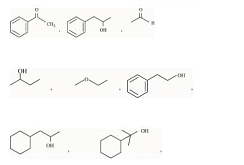Number of compounds giving (i) red colouration with ceric ammonium nitrate and also (ii) positive iodoform test from the following is_____


Correct Answer: 3
Solution and Explanation
Correct answer is (c)
Three compounds meet the criteria for both tests, indicating the presence of specific functional groups reactive to these tests. These compounds contain functional groups that react with ceric ammonium nitrate and the iodoform test:
Ceric ammonium nitrate is used to detect alcohols and phenols, where the reaction forms a color change.
The iodoform test is specific for methyl ketones, where the formation of a yellow precipitate (iodoform) indicates the presence of the functional group.
Thus, the three compounds must contain alcohols, phenols, or methyl ketones to show a positive result for both tests.

Top Questions on Haloalkanes and Haloarenes
- Observe the following set of reactions
2-Methylpropene $\xrightarrow{\text{HBr}, (\text{CH}_3\text{COO})_2}$ Y
2-Methylpropene $\xrightarrow{\text{HBr}}$ X
Correct statement regarding X and Y is- TS EAMCET - 2025
- Chemistry
- Haloalkanes and Haloarenes
- Identify the chain isomers from the following
- TS EAMCET - 2025
- Chemistry
- Haloalkanes and Haloarenes
- What are X and Y in the following reaction sequence?

- TS EAMCET - 2025
- Chemistry
- Haloalkanes and Haloarenes
- X and Y in reactions:

- TS EAMCET - 2025
- Chemistry
- Haloalkanes and Haloarenes
- Benzene when treated with Br\(_2\) in the presence of FeBr\(_3\), gives 1,4-dibromobenzene and 1,2-dibromobenzene. Which type of reaction is this?
- KEAM - 2025
- Chemistry
- Haloalkanes and Haloarenes
Questions Asked in JEE Main exam
Consider the following sequence of reactions :

Molar mass of the product formed (A) is ______ g mol\(^{-1}\).- JEE Main - 2025
- Organic Chemistry
The magnitude of heat exchanged by a system for the given cyclic process ABC (as shown in the figure) is (in SI units):

- JEE Main - 2025
- Electric charges and fields
- The value of \( (\sin 70^\circ)(\cot 10^\circ \cot 70^\circ - 1) \) is:
- JEE Main - 2025
- Trigonometric Identities
- The number of 6-letter words, with or without meaning, that can be formed using the letters of the word "MATHS" such that any letter that appears in the word must appear at least twice is:
- JEE Main - 2025
- Calculus
- 10 mL of 2 M NaOH solution is added to 20 mL of 1 M HCl solution kept in a beaker. Now, 10 mL of this mixture is poured into a volumetric flask of 100 mL containing 2 moles of HCl and made the volume upto the mark with distilled water. The solution in this flask is :
- JEE Main - 2025
- Solutions
Concepts Used:
Haloalkanes and Haloarenes
The hydrocarbons such as Haloalkanes and Haloarenes are the ones, in which one or more hydrogen atoms are replaced with halogen atoms. The main difference between Haloalkanes and Haloarenes is that Haloalkanes are derived from open chained hydrocarbons, also called alkanes, and Haloarenes are derived from aromatic hydrocarbons.
- Haloalkanes have hydrocarbons made up of aliphatic alkanes and one or more hydrogen atoms replaced by halogens (elements such as Chlorine, Bromine, Fluorine, Iodine, etc.) whereas, haloarenes consist of aromatic ring or rings and one or more hydrogen atoms replaced by halogens.
- In haloalkanes, the halogen atom is attached to the sp3 hybridized carbon atom of the alkyl group whereas, in haloarenes, the halogen atom is attached to the sp3 hybridized carbon atom of the alkyl group.
- Haloalkanes are saturated organic compounds where all the chemical bonds are attached to the carbon atom with single bonds and a single carbon atom is attached to the Halogen atom, whereas, the haloarenes differ from Haloalkanes by their method of preparation and properties.
- Haloalkanes are made by aliphatic alkanes by the process of free radical halogenation, whereas, haloarenes are made by direct halogenation of aromatic rings.
- Haloalkanes are odorless compounds, whereas, haloarenes have a sweet odor.
- Haloalkanes precipitate in SN2 substitution reactions, whereas, haloarenes do not precipitate in SN2 substitution reactions.
- Example of haloalkanes is CH3Cl (Methyl Chloride) and CH3CH2Br (Ethyl Bromide) and the example of haloarenes is Chlorobenzene, Bromobenzene.